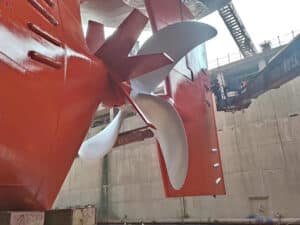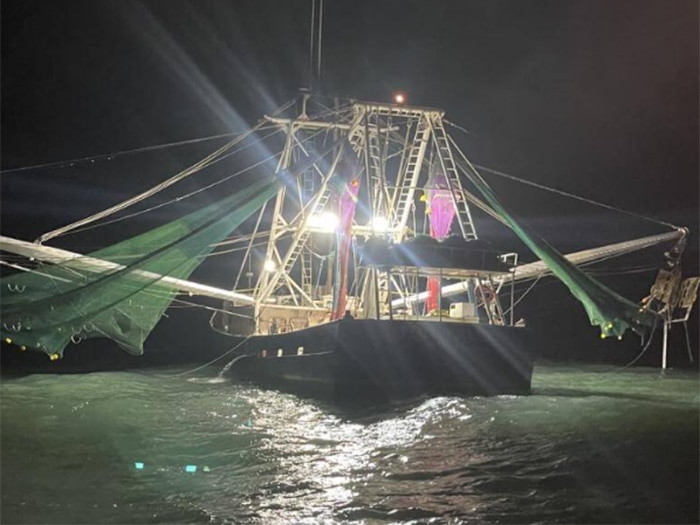
Did hull plating deterioration lead to Captain Alex flooding and sinking?
Written by Nick Blenkey
The Captain Alex pictured just after the U.S. Coast Guard arrived on scene. [Photo: U.S. Coast Guard]
Uncontrolled flooding through a hole in the plating beneath the engine room of the 1996-built fishing vessel Captain Alex led to its sinking in the Gulf of Mexico, the National Transportation Safety Board said in a report released Thursday, which says the hole was possibly caused by steel hull plating deterioration—beneath the engine room.
The 86.7-foot-long, 165-gross-ton, steel-hulled freezer trawler Captain Alex was fishing offshore of Galveston, Texas on Nov. 25, 2022, when it began flooding. The four crewmembers on board were unable to stem the flooding and evacuated to a responding U.S. Coast Guard boat. The sinking resulted in an oil sheen and debris field; a reported 17,000 gallons of diesel fuel were on board. There were no injuries. The Captain Alex was a total loss valued at $500,000.
The Coast Guard responded to the Captain Alex’s call for assistance as the vessel was taking on water. The Coast Guard floated a dewatering pump to the crew; however, the pump was not able to pull water and later broke. With the vessel continuing to take on water, the crew evacuated the vessel.
A postcasualty exam of the Captain Alex did not occur as the wreckage was not salvaged. The investigation was unable to obtain information about hull maintenance, and the last vessel survey noted that no recent hull gauging report or maintenance records were available. It is possible the hole was caused by the deterioration of the hull steel plating.
ANALYSIS
In its analysis of the accident, the full NTSB report says:
“The Coast Guard states in Navigation and Inspection Circular 7-68 (NVIC 7-68),
Notes on Inspection and Repair of Steel Hulls, that “deterioration of the metal
structure is probably the most common, single defect in steel vessels.” According to
the circular, the causes of deterioration include age, inadequate maintenance, and
electrolysis. The Coast Guard notes that ‘the only practical way of determining the
degree of deterioration is to measure the thickness of the member in question and
compare it with the original thickness.’ Investigators were unable to obtain
information about previous inspections, hull plate gaugings, or maintenance carried
out on the hull. Further, a surveyor noted in a July 2021 condition valuation survey
that no recent gauging report or maintenance records were available during the
survey. Without evidence that the vessel was damaged or flooding originated from
another source, it is possible that the flooding was caused by deterioration of the hull
steel plating.”
“Periodic out-of-water examinations by qualified individuals such as a marine inspectors or surveyors can help determine the material condition of the vessel’s hull and identify areas of corrosion and fatigue,” the report said. “For steel-hulled vessels, regular gauging of the hull using ultrasonic testing is an effective nondestructive testing method for identifying material deterioration of plating.”
LESSONS LEARNED
Hull Examination and Maintenance: Periodic out-of-water examinations by qualified individuals such as a marine inspectors or surveyors can help determine the material condition of the vessel’s hull and identify areas of corrosion and fatigue. For steel-hulled vessels, regular gauging of the hull using ultrasonic testing is an effective nondestructive testing method for identifying material deterioration of plating.
- Download the full NTSB Captain Alex sinking report HERE




